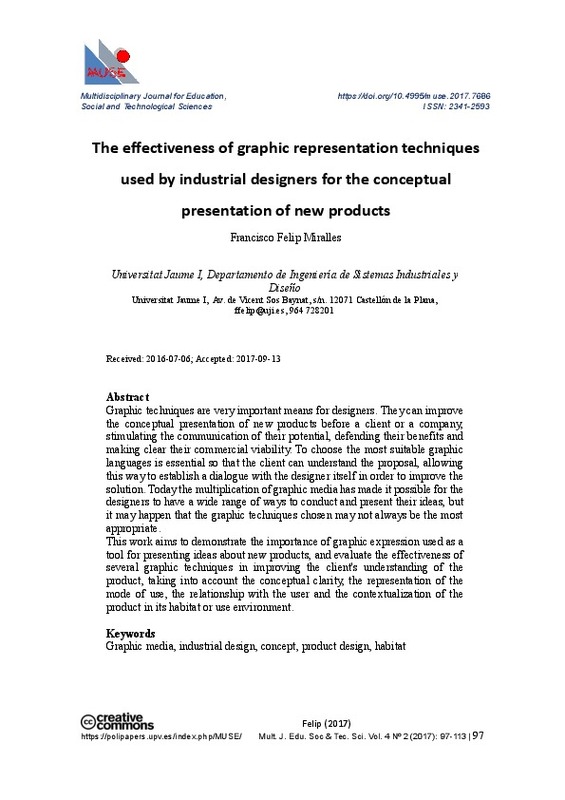JavaScript is disabled for your browser. Some features of this site may not work without it.
Buscar en RiuNet
Listar
Mi cuenta
Estadísticas
Ayuda RiuNet
Admin. UPV
The effectiveness of graphic representation techniques used by industrial designers for the conceptual presentation of new products
Mostrar el registro sencillo del ítem
Ficheros en el ítem
| dc.contributor.author | Felip Miralles, Francisco
|
es_ES |
| dc.date.accessioned | 2017-10-31T08:20:33Z | |
| dc.date.available | 2017-10-31T08:20:33Z | |
| dc.date.issued | 2017-09-27 | |
| dc.identifier.uri | http://hdl.handle.net/10251/90288 | |
| dc.description.abstract | [EN] Graphic techniques are very important means for designers. They can improve the conceptual presentation of new products before a client or a company, stimulating the communication of their potential, defending their benefits and making clear their commercial viability. To choose the most suitable graphic languages is essential so that the client can understand the proposal, allowing this way to establish a dialogue with the designer itself in order to improve the solution. Today the multiplication of graphic media has made it possible for the designers to have a wide range of ways to conduct and present their ideas, but it may happen that the graphic techniques chosen may not always be the most appropriate. This work aims to demonstrate the importance of graphic expression used as a tool for presenting ideas about new products, and evaluate the effectiveness of several graphic techniques in improving the client's understanding of the product, taking into account the conceptual clarity, the representation of the mode of use, the relationship with the user and the contextualization of the product in its habitat or use environment. | es_ES |
| dc.language | Inglés | es_ES |
| dc.publisher | Universitat Politècnica de València | |
| dc.relation.ispartof | Multidisciplinary Journal for Education, Social and Technological Sciences | |
| dc.rights | Reconocimiento - No comercial - Sin obra derivada (by-nc-nd) | es_ES |
| dc.subject | Graphic media | es_ES |
| dc.subject | Industrial design | es_ES |
| dc.subject | Concept | es_ES |
| dc.subject | Product design | es_ES |
| dc.subject | Habitat | es_ES |
| dc.title | The effectiveness of graphic representation techniques used by industrial designers for the conceptual presentation of new products | es_ES |
| dc.type | Artículo | es_ES |
| dc.date.updated | 2017-10-31T08:13:01Z | |
| dc.identifier.doi | 10.4995/muse.2017.7686 | |
| dc.rights.accessRights | Abierto | es_ES |
| dc.contributor.affiliation | Universitat Politècnica de València. Departamento de Expresión Gráfica Arquitectónica - Departament d'Expressió Gràfica Arquitectònica | es_ES |
| dc.description.bibliographicCitation | Felip Miralles, F. (2017). The effectiveness of graphic representation techniques used by industrial designers for the conceptual presentation of new products. Multidisciplinary Journal for Education, Social and Technological Sciences. 4(2):97-113. https://doi.org/10.4995/muse.2017.7686 | es_ES |
| dc.description.accrualMethod | SWORD | es_ES |
| dc.relation.publisherversion | https://doi.org/10.4995/muse.2017.7686 | es_ES |
| dc.description.upvformatpinicio | 97 | es_ES |
| dc.description.upvformatpfin | 113 | es_ES |
| dc.type.version | info:eu-repo/semantics/publishedVersion | es_ES |
| dc.description.volume | 4 | |
| dc.description.issue | 2 | |
| dc.identifier.eissn | 2341-2593 | |
| dc.description.references | Bishop, I., & Lange, E. (2005). Presentation Style and Technology. En I. Bishop & E. Lange (Eds.), Visualization in landscape and enviromental planning: technology and applications (pp. 68-77). New York: Taylor&Francis. | es_ES |
| dc.description.references | Brath, R., Peters, M., & Senior, R. (s. f.). Visualization for Communication: The Importance of Aesthetic Sizzle. Ninth International Conference on Information Visualisation (IV’05). doi:10.1109/iv.2005.145 | es_ES |
| dc.description.references | Crilly, N., Blackwell, A. F., & Clarkson, P. J. (2006). Graphic elicitation: using research diagrams as interview stimuli. Qualitative Research, 6(3), 341-366. doi:10.1177/1468794106065007 | es_ES |
| dc.description.references | Chulvi, V., Mulet, E., Felip, F., & García-García, C. (2016). The effect of information and communication technologies on creativity in collaborative design. Research in Engineering Design, 28(1), 7-23. doi:10.1007/s00163-016-0227-2 | es_ES |
| dc.description.references | García-García, C., Chulvi, V., Galán Serrano, J., Felip, F., Royo González, M. (2015) The use of social networks for invigorate the communication during the conceptual design phase in virtual projects. In Proceedings of 19th International Congress on Project Management and Engineering, Granada, Spain (pp. 277-290). AEIPRO | es_ES |
| dc.description.references | García-García, C., Chulvi, V., Mulet Escrig, E., Felip, F. (2016) Comparative study of digital sketching tools for conceptual design of new products. In Proceedings of 20th International Congress on Project Management and Engineering, Cartagena, Spain (pp. 1028-1040). AEIPRO. http://www.aeipro.com/files/congresos/2016cartagena/03030.4603.pdf | es_ES |
| dc.description.references | González Alastrué, J. A., & Jover, L. (2004). Los gráficos en la comunicación y el razonamiento científicos: ¿instrumento u ornamento? Medicina Clínica, 122(Supl.1), 3-10. doi:10.1157/13057541 | es_ES |
| dc.description.references | Herbert, D. M. (1988). Study Drawings in Architectural Design: Their Properties as a Graphic Medium. Journal of Architectural Education, 41(2), 26-38. doi:10.1080/10464883.1988.10758473 | es_ES |








